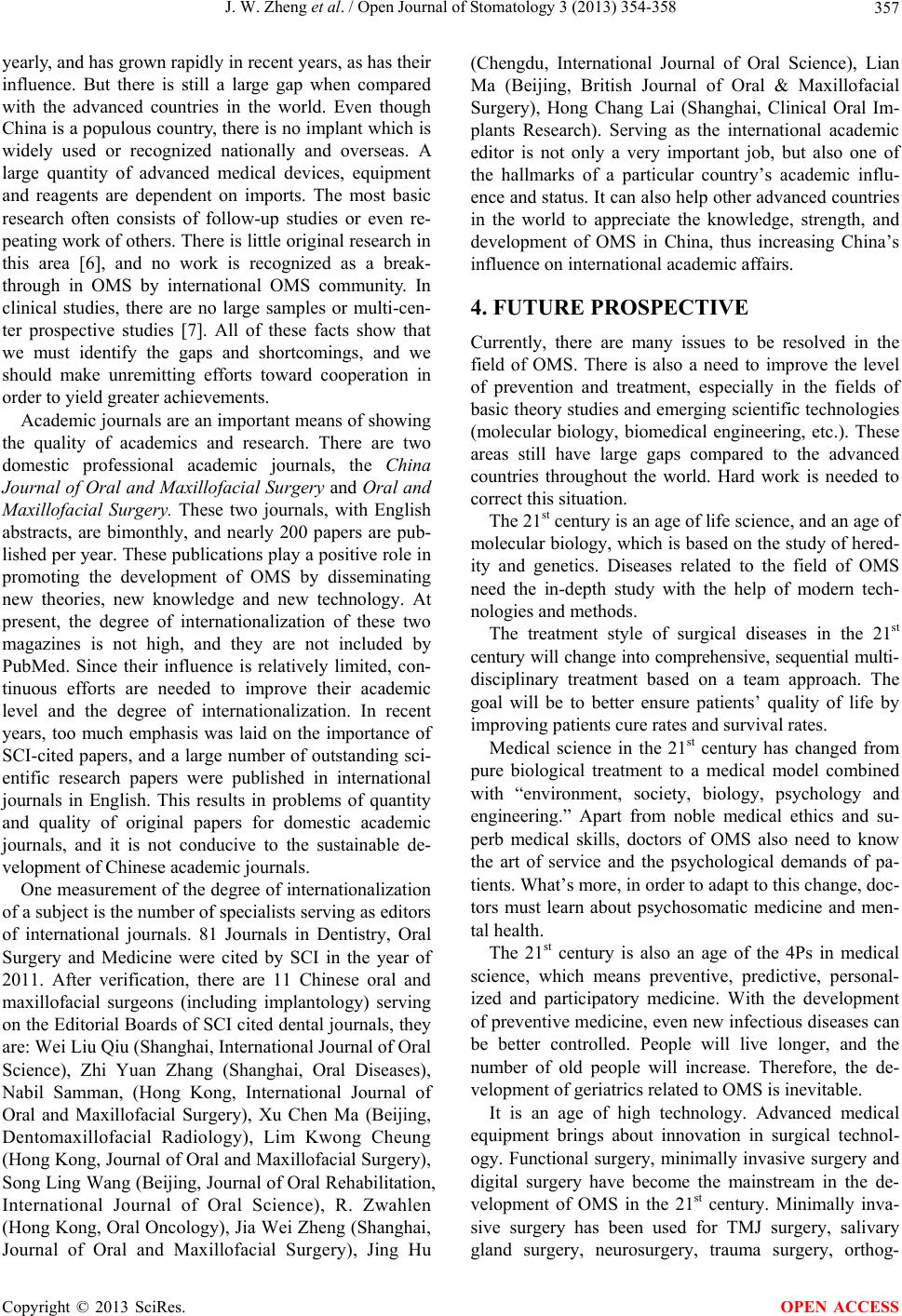
J. W. Zheng et al. / Open Journal of Stomatology 3 (2013) 354-358 357
yearly, and has grown rapidly in recent years, as has their
influence. But there is still a large gap when compared
with the advanced countries in the world. Even though
China is a populous cou ntry, there is no implant wh ich is
widely used or recognized nationally and overseas. A
large quantity of advanced medical devices, equipment
and reagents are dependent on imports. The most basic
research often consists of follow-up studies or even re-
peating work of others. There is little original research in
this area [6], and no work is recognized as a break-
through in OMS by international OMS community. In
clinical studies, there are no large samples or multi-cen-
ter prospective studies [7]. All of these facts show that
we must identify the gaps and shortcomings, and we
should make unremitting efforts toward cooperation in
order to yield greater achievements.
Academic journals are an important means of showing
the quality of academics and research. There are two
domestic professional academic journals, the China
Journal of Oral an d Maxillofacial Surgery and Oral and
Maxillofacial Surgery. These two journals, with English
abstracts, are bimonthly, and nearly 200 papers are pub-
lished per year. These publications play a positive role in
promoting the development of OMS by disseminating
new theories, new knowledge and new technology. At
present, the degree of internationalization of these two
magazines is not high, and they are not included by
PubMed. Since their influence is relatively limited, con-
tinuous efforts are needed to improve their academic
level and the degree of internationalization. In recent
years, too much emphasis was laid on the importance of
SCI-cited papers, and a large number of outstanding sci-
entific research papers were published in international
journals in English. This results in problems of quantity
and quality of original papers for domestic academic
journals, and it is not conducive to the sustainable de-
velopment of Chinese academic journals.
One measurement of the degree of internationalization
of a subject is the number of specialists serving as editors
of international journals. 81 Journals in Dentistry, Oral
Surgery and Medicine were cited by SCI in the year of
2011. After verification, there are 11 Chinese oral and
maxillofacial surgeons (including implantology) serving
on the Editorial Board s of SCI cited dental journals, they
are: Wei Liu Qiu (Shanghai, International Journal of Oral
Science), Zhi Yuan Zhang (Shanghai, Oral Diseases),
Nabil Samman, (Hong Kong, International Journal of
Oral and Maxillofacial Surgery), Xu Chen Ma (Beijing,
Dentomaxillofacial Radiology), Lim Kwong Cheung
(Hong Kong, Journal of Oral and Maxillofacial Surg ery),
Song Ling Wang (Beijing, Journal of Oral Rehabilitatio n,
International Journal of Oral Science), R. Zwahlen
(Hong Kong, O ral Oncology), Jia Wei Zh eng (Shanghai,
Journal of Oral and Maxillofacial Surgery), Jing Hu
(Chengdu, International Journal of Oral Science), Lian
Ma (Beijing, British Journal of Oral & Maxillofacial
Surgery), Hong Chang Lai (Shanghai, Clinical Oral Im-
plants Research). Serving as the international academic
editor is not only a very important job, but also one of
the hallmarks of a particular country’s academic influ-
ence and status. It can also help other advanced countries
in the world to appreciate the knowledge, strength, and
development of OMS in China, thus increasing China’s
influence on international academic affairs.
4. FUTURE PROSPECTIVE
Currently, there are many issues to be resolved in the
field of OMS. There is also a need to improve the level
of prevention and treatment, especially in the fields of
basic theory studies and emerging scientific technologies
(molecular biology, biomedical engineering, etc.). These
areas still have large gaps compared to the advanced
countries throughout the world. Hard work is needed to
correct this situation.
The 21st century is an age of life science, and an age of
molecular biology, which is based on the study of hered-
ity and genetics. Diseases related to the field of OMS
need the in-depth study with the help of modern tech-
nologies and methods.
The treatment style of surgical diseases in the 21st
century will chan ge into comprehensive, sequ ential multi-
disciplinary treatment based on a team approach. The
goal will be to better ensure patients’ quality of life by
improving patients cure rates and survival rates.
Medical science in the 21st century has changed from
pure biological treatment to a medical model combined
with “environment, society, biology, psychology and
engineering.” Apart from noble medical ethics and su-
perb medical skills, doctors of OMS also need to know
the art of service and the psychological demands of pa-
tients. What’s more, in order to adapt to this change, doc-
tors must learn about psychosomatic medicine and men-
tal health.
The 21st century is also an age of the 4Ps in medical
science, which means preventive, predictive, personal-
ized and participatory medicine. With the development
of preventive medicine, even new infectious diseases can
be better controlled. People will live longer, and the
number of old people will increase. Therefore, the de-
velopment of geriatrics related to OMS is inevitable.
It is an age of high technology. Advanced medical
equipment brings about innovation in surgical technol-
ogy. Functional surgery, minimally invasive surgery and
digital surgery have become the mainstream in the de-
velopment of OMS in the 21st century. Minimally inva-
sive surgery has been used for TMJ surgery, salivary
gland surgery, neurosurgery, trauma surgery, orthog-
Copyright © 2013 SciRes. OPEN ACCESS